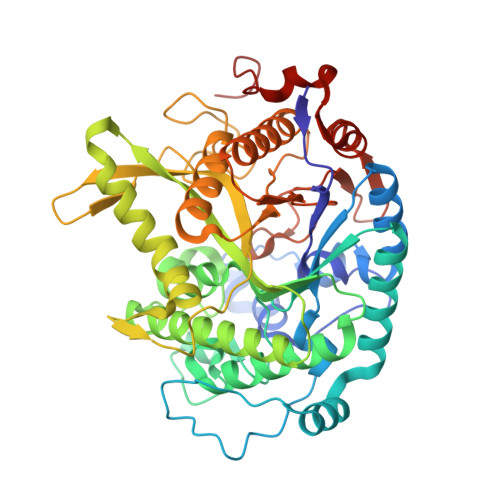Full and Partial Agonism of a Designed Enzyme Switch.
Budiardjo, S.J., Licknack, T.J., Cory, M.B., Kapros, D., Roy, A., Lovell, S., Douglas, J., Karanicolas, J.(2016) ACS Synth Biol 5: 1475-1484
- PubMed: 27389009
- DOI: https://doi.org/10.1021/acssynbio.6b00097
- Primary Citation of Related Structures:
5IXE - PubMed Abstract:
Chemical biology has long sought to build protein switches for use in molecular diagnostics, imaging, and synthetic biology. The overarching challenge for any type of engineered protein switch is the ability to respond in a selective and predictable manner that caters to the specific environments and time scales needed for the application at hand. We previously described a general method to design switchable proteins, called "chemical rescue of structure", that builds de novo allosteric control sites directly into a protein's functional domain. This approach entails first carving out a buried cavity in a protein via mutation, such that the protein's structure is disrupted and activity is lost. An exogenous ligand is subsequently added to substitute for the atoms that were removed by mutation, restoring the protein's structure and thus its activity. Here, we begin to ask what principles dictate such switches' response to different activating ligands. Using a redesigned β-glycosidase enzyme as our model system, we find that the designed effector site is quite malleable and can accommodate both larger and smaller ligands, but that optimal rescue comes only from a ligand that perfectly replaces the deleted atoms. Guided by these principles, we then altered the shape of this cavity by using different cavity-forming mutations, and predicted different ligands that would better complement these new cavities. These findings demonstrate how the protein switch's response can be tuned via small changes to the ligand with respect to the binding cavity, and ultimately enabled us to design an improved switch. We anticipate that these insights will help enable the design of future systems that tune other aspects of protein activity, whereby, like evolved protein receptors, remolding the effector site can also adjust additional outputs such as substrate selectivity and activation of downstream signaling pathways.
Organizational Affiliation:
Center for Computational Biology, ‡Department of Molecular Biosciences, §High Throughput Screening Laboratory, ∥Protein Structure Laboratory, ⊥Molecular Structures Group The University of Kansas , 2030 Becker Drive, Lawrence, Kansas 66045-7534, United States.

















